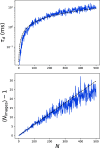Refractive lensing of scintillating FRBs by subparsec cloudlets in the multiphase CGM
- PMID: 39288177
- PMCID: PMC11441562
- DOI: 10.1073/pnas.2406783121
Refractive lensing of scintillating FRBs by subparsec cloudlets in the multiphase CGM
Abstract
We consider the refractive lensing effects of ionized cool ([Formula: see text]) gas cloudlets in the circumgalactic medium (CGM) of galaxies. In particular, we discuss the combined effects of lensing from these cloudlets and scintillation from plasma screens in the Milky Way interstellar medium (ISM). We show that, if the CGM comprises a mist of subparsec cloudlets with column densities of order [Formula: see text] (as predicted by [M. McCourt, S. P. Oh, R. O'Leary, A. M. Madigan, MNRAS 473, 5407-5431 (2018)]), then fast radio bursts (FRBs) whose sightlines pass within a virial radius of a CGM halo will may be lensed into tens of refractive images with a ∼10 ms scattering timescale. When these images are formed, they will be resolved by scintillating screens in the Milky Way ISM and will suppress the observed scintillation. We illustrate this effect in refractive lensing and argue that positive detections of FRB scintillation may constrain the properties of these cool-gas cloudlets, with current scintillation observation weakly disfavoring the cloudlet model. We propose that sheet-like geometries for the cool gas in the CGM can reconcile quasar absorption measurements (from which we infer the presence of the cool gas with structure on subparsec scales) and the unexpected lack of lensing signals from this gas thus far observed.
Keywords: circumgalactic medium; fast radio bursts; plasma lensing; scintillation.
Conflict of interest statement
Competing interests statement:The authors declare no competing interest.
Figures




References
-
- Prochaska J. X., Hennawi J. F., Quasars probing quasars. III. New clues to feedback, quenching, and the physics of massive galaxy formation. APJ 690, 1558–1584 (2009).
-
- Stocke J. T., et al. , Characterizing the circumgalactic medium of nearby galaxies with HST/COS and HST/STIS absorption-line spectroscopy. APJ 763, 148 (2013).
-
- Lau M. W., Prochaska J. X., Hennawi J. F., Quasars probing quasars. VIII. The physical properties of the cool circumgalactic medium surrounding z 2–3 massive galaxies hosting quasars. APJS 226, 25 (2016).
-
- Cantalupo S., Arrigoni-Battaia F., Prochaska J. X., Hennawi J. F., Madau P., A cosmic web filament revealed in Lyman-α emission around a luminous high-redshift quasar. Nature 506, 63–66 (2014). - PubMed
-
- Hennawi J. F., Prochaska J. X., Cantalupo S., Arrigoni-Battaia F., Quasar quartet embedded in giant nebula reveals rare massive structure in distant universe. Science 348, 779–783 (2015). - PubMed
Grants and funding
- n/a/Ontario Research Fund-Research Exellence Program
- RGPIN-2019-067 CRD 523638-18 555585-2/Canadian Government | Natural Sciences and Engineering Research Council of Canada (NSERC)
- n/a/Canadian Institute for Advanced Research (ICRA)
- n/a/Canadian Foundation for Innovation
- 11929301/National Science Foundation of China
LinkOut - more resources
Full Text Sources
Medical

